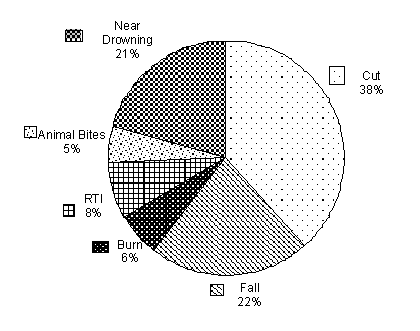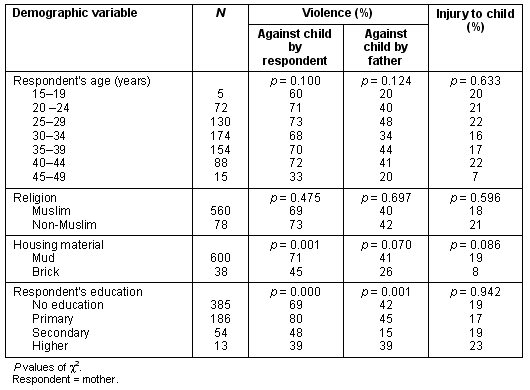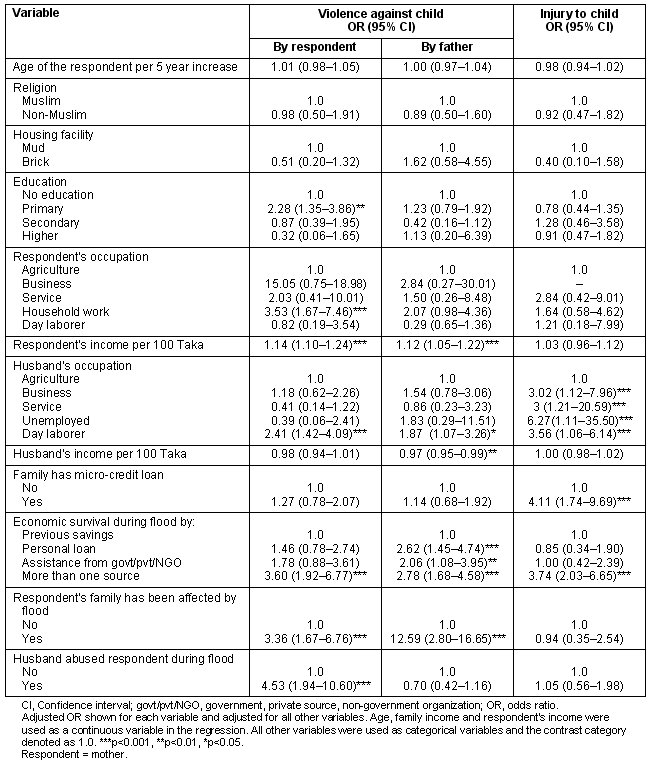Introduction
Floods are the most common natural disaster resulting in socio-economic damage and adverse human health consequences, including injuries1,2. The health impacts of floods vary according to the vulnerability of flood victims and the type of flood3-6. WHO (2008) argues that very few scientific publications have tried to quantify the health impacts of floods2. Injuries are a neglected public health problem, especially in the developing world7-10. Clemens et al. found that floods increased the risk of domestic violence11; however, there are few scientific studies into flood-related injuries.
Violence against children is a major public health problem, especially in developing countries10,12,13. The effects of violence on a child's wellbeing are significant and include medical and psychological problems such as depression, eating disorders, post-traumatic stress disorder (PTSD), and chronic pain, chronic fatigue and irritable bowel syndromes13. These effects are likely to be long-term, with adults who were abused as children reporting poor health status, greater use of healthcare facilities, and risk-taking behaviours including smoking, increased alcohol intake, abuse of drugs and unsafe sex10,13. Despite this, violence against children is under-studied in developing countries10,13,14.
Bangladesh is well known for its annual flood disasters. The Bangladesh Health and Injury Survey (BHIS, 2005) that investigated injuries and violence during floods in rural Bangladesh found that injuries are the leading cause of death in post-infancy children12. Therefore, this study investigated the unintentional injury of children and violence towards them by their parents during floods in rural Bangladesh. The article also explores the association of socioeconomic characteristics with violence against children in rural Bangladesh.
Methods
Study areas
The study was conducted in 45 villages of 5 unions (Brommogacha, Dhangora, Chandaikona, Dhubil, Ghurka) in Raiganj Upazilla (sub-district) of Sirajganj District. (A 'union' is the lowest administrative unit and the first step of the local government system in Bangladesh). Raiganj is situated in the north of Bangladesh, 185 km from the capital city Dhaka, and Sirajganj is affected by floods almost every year during the rainy season from mid-June to August.
Study participants, design and period
The study participants were randomly selected women of reproductive age (15-49 years) with at least one child of less than 18 years at home during the floods. A cross-sectional household survey was conducted from mid-September to the end of October 2007, spanning flooding from the end of July to mid-September in Bangladesh in 2007 (two floods occurred: in early August and early September).
Sampling
Both purposive and random sampling methods were used. To capture the optimum effect of the floods the study areas were selected purposively (Sirajganj is a flood-prone district and Brommogacha, Dhangora, Chandaikona, Dhubil, Ghurka are the 5 most flood affected unions in Raiganj Upazilla). To increase monitoring and supervision of the study, from each union-at-a-stretch 9 villages were purposive selected (one after another).
From the 45 villages selected, 974 households were randomly selected. From each selected household, mothers who met the inclusion criteria were enrolled for interview. The 638 women who participated in the interviews represented a 65% response rate. The remainder were either absent when the data collector called or declined the invitation to participate.
Questionnaire and data collection
Selected respondents were interviewed face-to-face using the pre-tested semi-structured English-language questionnaires. To enhance respondents' comprehension the questionnaires were translated into the Bengali language after translation and back translation. The pre-test provided necessary adjustments for the final questionnaires and also valuable information about how to approach the sensitive topic of violence among the respondents and discerning their socioeconomic variables.
The interviewers were trained and had been conducting interviews in the same geographical area for injury surveillance in the previous 3 years. The interview team for the current study consisted of two data collectors and one supervisor.
Initially, all prospective respondents were informed about the objectives and procedures of the study. Verbal consent was sought from the respondents because most were illiterate and could not provide written consent. The interviews were of 15-20 min duration and took place at the respondent's home.
The respondents were asked about the effect of flooding on their families in terms of nutrition, food habits, violence against children by respondents and their husbands, and unintentional injuries of children. They were also asked about their socioeconomic characteristics and means of economic survival during floods, and demographic information was sought.
Violence against children was defined as emotional, physical and sustenance abuse. Emotional abuse included excessive and aggressive shouting, screaming and threatening the child within the last 7 days. Physical abuse included striking, slapping, pushing, hair/ear pulling and throwing the child during the last 7 days. Sustenance abuse involved stopping the child's food and supplements within the last 7 days13.
Dependent variables
Violence against children by their mothers (the respondents) and fathers (the husbands of the respondents) within the last week, and the children's unintentional injuries during the floods were the primary interests of the study. The responses to questions about these variables were dichotomous (yes/no).
Injuries of the children
The respondents were asked about incidence of the following unintentional injuries to their children during the floods: cuts, falls, burns, animal bites including snake bites, road traffic injuries and near drowning.
Independent variables
The following were used as independent variables in this study:
- the respondent's and husband's occupation, categorized as household work (for women) and agriculture, business, service, unemployed or daily labor (for men)
- whether the family had a micro-credit loan
- the monthly incomes of the respondent and her husband
- their economic sources of survival (especially in regard to obtaining food during the floods), measured according to previous savings, personal loans, assistance from government /private organization/NGOs or more than one source
- whether respondents were abused by their husbands during the floods (including emotional, physical and sexual violence).
The respondent's opinion on whether her family was affected by floods was not requested.
Demographic variables were the respondent's:
- age and religion
- house material (mud/clay or bricks and cement)
- education (no education, primary, secondary or higher education).
Operational definitions
Injuries: Major child injuries were defined according to categories such as cuts, falls, burns, road traffic accidents, animal bites and near drowning. Data were also collected on the mechanism of injury. Injuries were defined as having occurred when a person was ill for 3 consecutive days after an event and unable to carry out regular daily activities, or when the person sought medical treatment from any healthcare provider after an injury event.
Emotional violence: Emotional violence was said to occur when a child's parent said or did something to humiliate the child in front of others, or in front of someone close to the child, or threatened the child with harm. This definition was also applied to a husband abusing the respondent.
Physical violence: The respondent or her husband physically abused their child by pushing, shaking, throwing something at him or her, slapping or twisting, punching with a closed fist or with something that could hurt, kicking or dragging the child, by trying to burn, strangle or attack the child with a knife, gun or any other type of weapon.
Sustenance abuse: Sustenance abuse was said to have taken place when the respondent or her husband or both stopped the daily food intake to the child; or if the respondent's husband stopped food intake for the respondent (his wife).
Sexual violence: Sexual violence was defined as respondent's husband physically forcing her to have sexual intercourse with him against her wishes, or forcing the respondent to perform other sexual acts against her wishes.
Statistical analysis
The χ2 test was used to examine differences in proportions of violence against children and their injuries according to demographic variables. To assess the independent contribution of the independent variables in predicting exposure to violence against children and their injuries, logistic regression was run with all the independent variables included in the model. In the logistic regression, age per 5 year increase, respondent's income and husband's income per 100 Taka increase were considered continuous variables. The magnitude and direction of association were expressed through adjusted odds ratios. The contrast categories were denoted beside the concerned variables. Significant levels were expressed as p-values, with statistical significance assumed at p <0.05.
Results
The study found that 70% of mothers and 40% of fathers abused their children during a flood. The categories of violence used against children by their parents are presented (Table 1). More than 86% of respondents were abused by their husbands during a flood (emotional abuse 37%, physical abuse 48%, sustenance abuse 0.3% and sexual abuse 0.5%).
Table 1: Categories of violence against children and mother during a flood

The majority of families in rural Bangladesh survive on the main earner's (respondent's husbands) daily income from daily laboring (55%), agricultural work (20%) and business (19%). Almost all of the respondents (90%) reported that their families were severely affected by floods in terms of social, economic and residential factors. More than 75% of families have micro-credit loans. During a flood almost half the families (47%) survived by using their own financial savings, and others relied on personal loans (14%), assistance from public/private/NGO sources (11%), or a combination of these (28%).
More than 18% of children in the current study were injured during floods. These unintentional injuries included cuts (38%), falls (22%) and near drowning (21%) (Fig1).

Figure 1: Types of children's unintended injuries during a flood; RTI, Road traffic injury.
The reason for children sustaining injuries was commonly given as lack of supervision while mothers were busy with household issues. During floods water inundation often affected a large part of the house, leaving only one room dry enough for her family members to use. A large number of children were under 5 years old and it was found that few children knew how to swim. One mother recounted her 4 year old child's near-drowning:
I was cooking food inside the room on the high up bench made of bamboo, water was running underneath, my child was behind me playing with toys. Suddenly I heard a sound of something falling in the water. My son was running after a wave and went outside the door. I jumped in the water and saved my child.
However, cut injuries were found to be the most frequent suffered by children during a flood. While exploring this phenomenon, the mother of a 5 year old girl who had cut herself said:
I don't have any kitchen to cook food during a flood as the mud-made oven in the yard has washed out in the water. One night I cooked food inside the room, with the knife lying just beside me. Somehow my girl found it and injured in her hand.
It was identified that due to a lack of suitable places to cook food during a flood, most people cooked food inside a room, meaning that sharp utensils were more accessible than usual to children.
Falls also occurred during a flood. One child slipped on a muddy surface and fractured his right hand. His mother said there was nothing she could do because the flood had made the whole area muddy and slippery. Her child was attracted to play in the mud and water away from supervision.
There were other causes of injury to children but most were due to the increase in surrounding water that limited living space. Sometimes an entire family was forced to share one room.
Respondents' demographics information is presented (Table 2). Religion was shown to have no relevance, and the proportion of mothers who commit child abuse during floods decreases as their educational level increases. Respondents and their husbands who lived in mud/clay houses were more violent towards their children compared with those who lived in brick houses.
Table 2: Incidence of violence against children by the respondent or her husband, and the unintended injuries of children during floods, according to demographic variable

Emotional violence was found to be the most frequent form of violence committed by parents. In exploring the reasons for this, one mother told us:
I can't stop my emotions during a devastating situation. My 6 years child always wants to know about this and about that and it disturbs me. So I say something bad to my child, I see my child's depressed face, but what I can do?
It was noted that mothers were under extreme mental pressure related to survival while their children often had no understanding of the gravity of the situation and behaved as if everything was normal.
At other times parents reported resorting to physical abuse to control their children, and most often it was the mothers who were physical violent towards their children. One father said:
My child always asked me in the morning to bring back cookies when I went outside to search for work. It was happening sometimes when we could only afford to eat once a day, so how could I buy cookies? I couldn't control myself and I slapped the child.
Due to the extremely difficult economic conditions during a flood, many rural Bangladeshis received a micro-credit loan to survive. With a lack of daily work during flooding the father was under pressure to feed his family. Children were often unaware of this.
A similar scenario occurred when husbands abused their wives, mostly physically and mentally. One mother said that her husband didn't want to hear anything about the family. When she was talking about how much rice was needed, her husband suddenly became angry and kicked her.
Most mothers believed that there was nothing they could do and everyone was hunting for better food and shelter. Survival was the major issue for them. In addition, food shortages often meant they could only prepare one to two meals a day for their family, which made them feel very anxious.
The logistic regression analysis demonstrated that parents' occupation is an important determinant of violence against children and their injuries during floods. Respondent's income per 100 Taka increase also elevated risk (OR 1.14; CI 1.10-1.24), but less than for occupation. Demographics such as a respondent's age, education, religion and housing material showed no significant relationship to violence against children and their injuries. Women engaged in household work abused their children three times more than women engaged in agriculture. Parental abuse of children was almost double in the families with daily earnings, compared with those with agricultural income. The means of economic survival were significantly related to violence and injury, which suggests flood-caused financial hardship in the family is an important determinant. Intimate partner violence was a significant risk factor for mother to child violence from during floods (Table 3). Children whose fathers were unemployed were five to six times more likely to be injured during floods.
Table 3: Violence against and unintended injury of children during a flood associated with demographic and other variables, according to perpetrator

Discussion
The high incidence of domestic violence after a large flood found in this study is consistent with the literature11,15. Lower socioeconomic conditions, low self-esteem, low empathy toward the child, poor impulse control, and mental health problems in the parent have been identified as the determinants of child abuse in the family16-19. A major natural disaster contributes to severe and chronic post-traumatic stress reactions in a substantial proportion of the adult population18,19. Increased stress is associated with disruption in families, challenges to meeting daily needs such as adequate food, water and shelter, as well as disruption to health and law enforcement services. All these increase the possibility of violence, especially within families. The current study was conducted in areas where the majority of families (90%) were affected by floods and struggling to find food and maintain shelter, stressors that increased the likelihood of violent behavior towards their children and other members of the family at home.
However, the violence against children by their parents (70% mothers and 40% fathers) during floods was found to be high in rural Bangladesh. An earlier study by Ahern and colleagues in 2005 indicated mainly disease epidemiology during floods20. In 1999 Clemens et al. studied the risk of domestic violence after floods in high income countries11; however, the current study focused on the injuries of children during floods in a developing country. There is insufficient material to compare this situation with children's injuries and violence suffered in other than normal conditions2. In this sense this study can only highlight the incidence of parental violence against children, and the injuries of children during floods in a low income country (Bangladesh). The findings may be best summarized according to what is already known and what this study adds.
What is already known:
- child injuries occur quite often in Bangladesh
- child injuries are under-reported
- there is a scarcity of information about child abuse during floods
- Bangladesh's population has a low socioeconomic status.
What this study adds:
- child abuse is common in Bangladesh
- floods may increase the risk of child abuse as a consequence of the parents' hardship
- women may be more likely to use emotional or deprivation abuse, while men are more likely to use physical abuse
- socioeconomic status is associated with child abuse and injuries during floods.
Demographic variables such as the respondent's age, religion and education appear to have no significant effect on parental child abuse and child injuries during floods. Ironically, neither the respondent's income nor their husband's has any such effect either. However, the study found that the occupation of the respondent and their husband had a significant effect on child abuse and child injuries. Women engaged in household tasks (without economic productivity) were found to be highly child abusive. The occupational status of the husband as daily income earner was associated with monetary insecurity and a lack of food security, clothing and shelter during floods. Even if the family members of daily income earners are accustomed to poverty, the absence of work during floods means these families become more socioeconomically vulnerable, which may increase parents' abuse of their children. This findings is consistent with the existing literature17,18.
The incidence of child injuries and violence against children and their mothers was higher among families living in low socioeconomic conditions, of low occupational status and those who were dependent on micro-credit loans during a flood. It is likely that the economic effect of a flood results in parents becoming increasingly concerned with survival strategies relating to food and shelter. A micro-credit loan taken out during a flood may have a negative psychological effect on a father. If his wife is already preoccupied with food and shelter issues, these overburdened parents may neglect their children, inadvertently exposing them to various types of injuries (drowning, burns, cuts, falls, animal injuries etc).
The current study suffers from the struggle for cross-sectional analysis to assign causality. It may also be limited by recall bias because the flood-affected respondents were not in a normal mental state due to increased socioeconomic and survival pressures. In such a state it becomes difficult to recall events accurately, and this may extend to enumerating child injuries and reporting abuse of their children inaccurately. It is therefore likely that the injury epidemiology highlighted in this study is actually under-reported. The mortality figure could not be reported accurately.
Interestingly, the type of housing material was found to have no significant effect on parental violence against children and child injuries. This may be due to the small sample size and cross-sectional study design. Therefore this could be regarded as a pilot study that indicates the need for a further large scale study in near future.
Violence against children has long-term physical and psychological effects on a child's wellbeing10,21-23 that persist and impact on long-term psycho-physical health in adulthood23,24. The frequencies and intensity of floods are increasing and it is a widely held belief that flood intensity and effects are greater in developing countries. Socioeconomic vulnerability and poor health status are part of daily life for the majority of those living in developing countries. In resource poor countries this situation is worsened during floods and compounded by subsequent violence towards and injuries suffered by children. Further studies are needed into child abuse at the time of natural flooding, and to clearly identify the mechanisms of injuries and the consequence of injuries and violence. Therefore, as a research initiator, the current study has some long-term policy implications for investing resources into further research into the social costs of large-scale flooding.
Dalal and his colleagues highlighted that violence against children in poor families is a serious childhood issue which is transmitted from one generation to the next25. The current study indicates that child abuse is a serious problem that increases in intensity during floods. Every year there are floods in Bangladesh. Therefore, the violence against children perpetuated as an intergenerational problem. This situation should not be accepted as inevitable. Building on the experience of this study, effective interventions such as parental education projects may serve to reduce the suffering of a new generation of children who would otherwise be affected by abuse and injuries during floods.
References
1. Few R, Matthies F. Flood hazards and health: responding to present and future risks, 1st edn. London: Earthscan, 2006.
2. WHO. What are the human health consequences of flooding and the strategies to reduce them? Geneva: Health Evidence Network, 2008.
3. Hajat S, Ebi KL, Kovats RS, Menne B, Edwards S, Haines A. The human health consequences of flooding in Europe and the implications for public health: a review of the evidence. Applied Environmental Science and Public Health 2003; 1: 13-21.
4. Malilay J. Floods. In: E Noji E (Ed.). The public health consequences of disasters. New York, NY: Oxford University Press 1997; 287-301.
5. Seaman J. Epidemiology of natural disasters. Basel, Switzerland: Karger, 1984.
6. Western K. Epidemiologic surveillance after natural disaster. Washington, DC: Pan American Health Organization, 1982.
7. Rahman A, Giashuddin SM, Svanström L, Rahman F. Drowning - a major but neglected child health problem in rural Bangladesh: implications for low income countries. International journal of injury control and safety promotion 2006; 13(2): 101-105.
8. Mohan D. Road traffic injuries--a neglected pandemic. Bulletin of World Health Organization 2003; 81(9): 684-685.
9. Mock C, Peden M, Hyder AA, Butchart A, Krug E. Child injuries and violence: the new challenge for child health. Bulletin of World Health Organization 2008; 86(6): 420.
10. WHO. World report on child injury prevention. Geneva: WHO, 2008.
11. Clemens P, Hietala JR, Rytter MJ, Schmidt RA, Reese DJ. Risk of domestic violence after flood impact: effects of social support, age, and history of domestic violence. Applied Behavioral Science Review 1999; 7(2): 199-206.
12. Director General of Health Services, Institute of Child and Mother Health, United Nations Children's Fund, The Alliance for Safe Children. Bangladesh Health and Injury Survey: Report on Children. Dhaka: Bangladesh Health and Injury Survey, 2003.
13. Dalal K. Causes and consequences of violence against child labour and women in developing countries. Stockholm: Karolinska Institutet, 2008.
14. Dalal K, Rahman F, Jansson B. The origin of violent behaviour among child labour in India. Global Public Health. 2008; 3(1): 77-92.
15. CDC. Disaster safety: preventing violence after a natural disaster. (Online) 2006. Available: http://bepreparedcalifornia.ca.gov/NR/rdonlyres/3C5E68A0-C8EC-4DD4-95C4-1EC0DDE5E28B/0/CDCPreventingViolenceafteraNaturalDisaster.pdf (Accessed 18 September 2008).
16. Wolfner G, Gelles RJ. A profile of violence toward children: a national study. Child Abuse & Neglect 1993; 17(2): 197-212.
17. Chalk R, King PA. Violence in families: assessing prevention and treatment programs. Washington, DC: National Academic Press, 1998.
18. Goenjian AK, Najarian LM, Pynoos RS, Steinberg AM, Manoukian G, Tavosian A et al. Posttraumatic stress disorder in elderly and younger adults after the 1988 earthquake in Armenia. The American Journal of Psychiatry 1994; 151: 895-901.
19. Goenjian AK, Molina L, Steinberg AM, Fairbanks LA, Alvarez ML, Goenjian HA et al. Posttraumatic stress and depressive reactions among Nicaraguan adolescents after hurricane Mitch. The American Journal of Psychiatry 2001; 158: 788-794.
20. Ahern M, Kovats RS, Wilkinson P, Few R, Matthies F. Global health impacts of floods: epidemiologic evidence. Epidemiologic Reviews 2005; 27(1): 36-46.
21. WHO. World report on violence and health. Geneva: WHO, 2002.
22. Tazima EA. The relative importance of wife abuse as a risk factor for violence against children. Child Abuse & Neglect 2000; 24(11): 1383-1398.
23. Dalal K, Rahman A. Out-of-pocket payments for unintentional injuries: a study in rural Bangladesh. International Journal of Injury Control and Safety Promotion 2009; 16(1): 41-47.
24. Jansson B, Stenbacka M, Leifman A, Romelsjö A. A small fraction of patients with repetitive injuries account for a large portion of medical costs. The European Journal of Public Health 2004; 14(2): 161-167.
25. National Centre for Elder Abuse. National elder abuse incidence study. Final report. Washington, DC: Administration for Children and Families, Administration on Aging, US Department of Health and Human Services, 1998.




